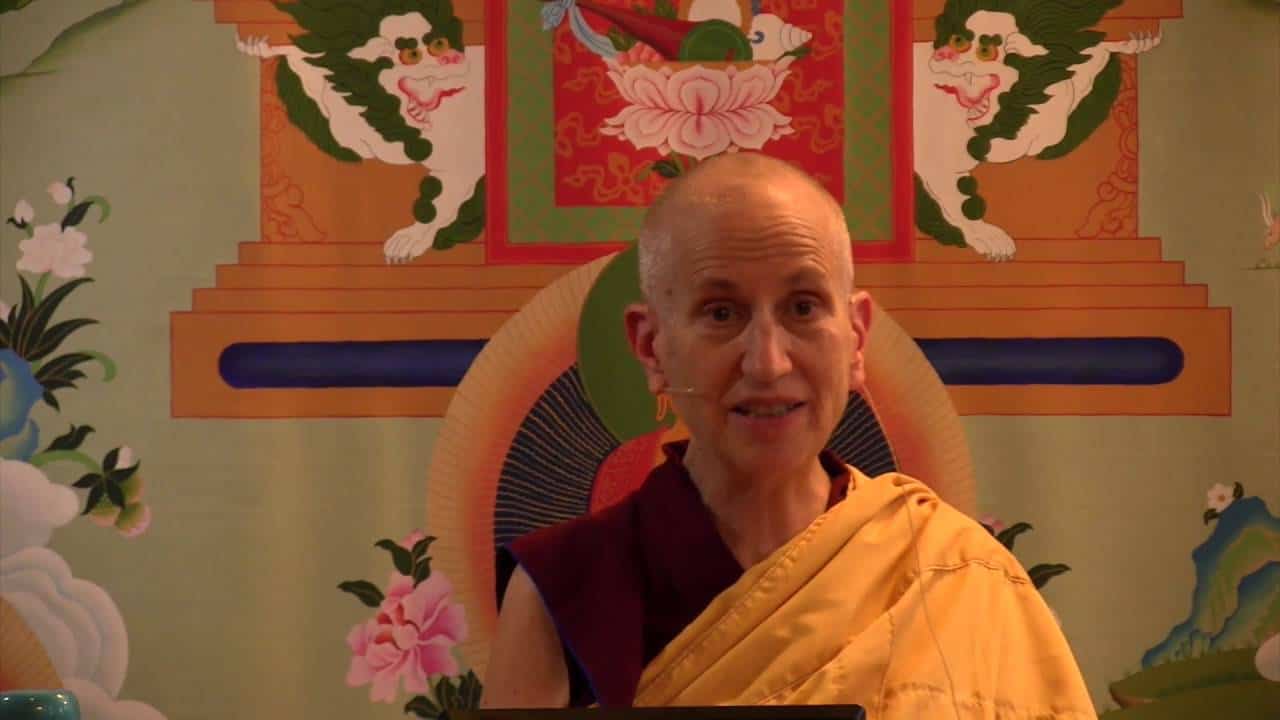The three types of attachment
Part of a series of teachings on a set of verses from the text Wisdom of the Kadam Masters.
Wisdom of the Kadam Masters: The three types of attachment (download)
The best sign of higher attainment is a decrease in your attachment.
Yesterday, in conjunction with the line about the greatest attainment is reducing our attachment, I just talked then about attachment in general, and attachment has many different forms. By attachment I mean a mind that is based on exaggerating the good qualities of someone or something and then clinging to it, wanting to hold onto it.
Another form of attachment is craving. There are three different kinds of craving that come up in our lives. One is craving for sensual pleasure. This is, we want nice sensual sensations, see good things, hear nice things, smell, taste, touch. Just really hooked on to the external world, and having a lot of attachment and craving for the objects that seem to spark our pleasant feelings. What we’re really attached to, of course, is the pleasant feelings, and the happiness. But then the objects seem to be the things that bring them, and so we get attached to the objects, too. That has its disadvantages in the sense that then our happiness is always dependent on external people and things which we can’t control. Whereas if, in our Dharma practice, what we’re trying to do is develop ourselves internally so that we are happy with whatever is happening at the moment, and aren’t so moved around by external people and external things. Gives us a lot more emotional stability.
The second type of craving is craving for existence. This means craving for a new rebirth, particularly rebirth in the upper realms where you’re born with states of very deep samadhi. The first kind of attachment for sense objects is, of course, not only in this life attachment to sense objects but attachment to be born in the desire realm, where we have all these sense objects. And then the second attachment, attachment to renewed existence, is attachment to rebirth in these states of very deep concentration where you’re not so dependent on external objects, but you still aren’t free from the cycle of existence, because the mind still has ignorance.
And then the third kind of craving, they call it craving for non-existence. What this means is when we have painful feelings we crave for them not to exist. We may have painful feelings of all different sorts—painful things from external objects, emotional pain, all these kinds of things, and so we crave for these kinds of sensations, and the objects that spark them, to cease. Again, you know, we’re always going back and forth in response to external objects, external people, we become emotional yo-yos. In an extreme case of this, the craving for non-existence, would be craving for the self to cease at the time of death. I think people who commit suicide think that that’s going to happen and they’re just wanting themselves to totally cease. The problem is that the self doesn’t cease at the time of death, and so suicide doesn’t relieve you from your pain at all.
We see with these three kinds of craving, the more our mind is involved in craving and wanting and “I need” and “I want” and “I have to have,” then the less peaceful the mind is, and the more dissatisfied we are, the more frustrated we are when we can’t get what we want. And so the whole idea in the Dharma behind relinquishing craving is to make our mind peaceful, and developing a sense of inner satisfaction, inner contentment, that basically has to do with being content with who we are as people. Because I think when we keep good ethical conduct, and are able to examine our motivations, and let go of the kind of corrupt ones, and have kind motivations, then we feel happier within ourselves. And when we feel happier within ourselves then our craving for external things decreases considerably. So in our spiritual practice we’re trying to create that inner kind of peace and contentment and satisfaction. And when we have that, then of course that gives us so much more mental space, as well as energy, to work for the benefit of others and to be of service to others. So that’s a good chunk of what our practice is about.
Venerable Thubten Chodron
Venerable Chodron emphasizes the practical application of Buddha’s teachings in our daily lives and is especially skilled at explaining them in ways easily understood and practiced by Westerners. She is well known for her warm, humorous, and lucid teachings. She was ordained as a Buddhist nun in 1977 by Kyabje Ling Rinpoche in Dharamsala, India, and in 1986 she received bhikshuni (full) ordination in Taiwan. Read her full bio.


